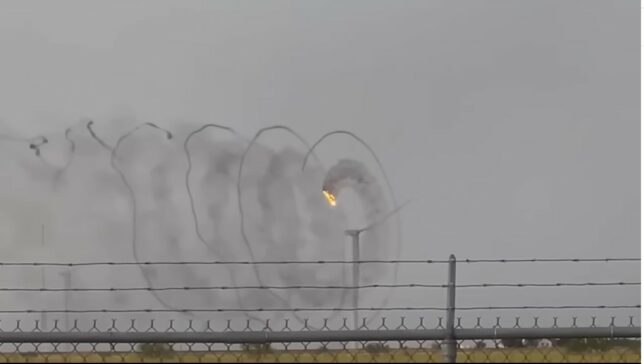Green Watch
NextEra Energy: “Exceedingly Rare” Incidents
 Wind turbine on fire near Crowell, Texas. Credit:
news.com.au/YouTube.
Wind turbine on fire near Crowell, Texas. Credit:
news.com.au/YouTube.

NextEra Energy: A Messy Green Goliath with Other People’s Money (full series)
The King of Green Power | The Sierra Wind Turbine Club
“Exceedingly Rare” Incidents | Not So Rare
“Exceedingly Rare” Incidents
Needless huge eyesores on the landscape aren’t the only threats presented by weather-dependent power companies.
On March 28, 2023, a NextEra-managed wind turbine in rural western New York caught fire. Mechanical fires atop tall poles placed in windy areas are obviously troublesome. In this case, according to a local newspaper, “fiberglass insulation material burned into the wind and was distributed across a wide area in the tiny town.” Residents endured “fiberglass particles on their land, stuck in trees, and presumably in ponds within the distribution area.”
“We believe this was an isolated incident,” said NextEra, in response to the fire.
But in March 2019, a turbine owned by NextEra in Nova Scotia caught fire in a brisk wind, producing images and reports that looked similar to the western New York incident four years later.
“We couldn’t get nowhere near because the blades was still turning, so, and pieces was breaking off the blades,” said a local fire chief. “So if a piece was to fall off, it would go a long ways with the wind and that. So it wasn’t safe to go nowhere near the tower at all.”
Explaining how the early spring snow in Atlantic Canada assisted in putting out the ignited debris flying all around, the fire chief observed the timing was lucky. “If that would have been August, we’d still be there trying to put wood fire out,” he said.
In January 2023, two months before the rain of flaming fiberglass in western New York, a NextEra-owned turbine collapsed in Wisconsin. The Milwaukee Journal-Sentinel reported in March 2023 that NextEra had still not given a reason for the failure of the 400-foot-tall structure.
But the firm gave a familiar reassurance: “We believe this was an isolated incident as turbine malfunctions are rare.”
A June 2017 Des Moines Register report featured dramatic video of a burning NextEra-owned turbine belching black smoke as its blades crashed to the ground. It was fortunate for all involved, yet hilariously ironic, that burning debris did not waft across the landscape during this incident. There doesn’t appear to have been a breeze blowing into the facility built to produce wind energy.
A NextEra official pronounced this fire “exceedingly rare” and said he could not “recall the last time one of these situations has happened.”
He spoke too soon. It was going to be a busy month.
Less than a week later, also in June 2017, a 426-foot-tall wind turbine tower owned by NextEra collapsed in Nebraska. It had been spinning for less than four years. The same NextEra official from the Iowa incident responded with another claim that wind turbine collapses are “very rare.”
A Nebraska TV station reported that “just last week a turbine in Northwest Iowa caught on fire and toppled,” but generously didn’t explain that it belonged to the same company.
Then a couple of weeks later, but still in June 2017, a blade crumpled on a 165-foot-tall NextEra-owned turbine in Michigan. “He says such breaks are rare,” reported the Associated Press, referencing the suddenly overworked NextEra spokesman.
In December 2020, a Wyoming wind turbine owned by NextEra caught fire after only a few months in operation. “Turbine fires are rare,” explained a NextEra statement.
In June 2022, a 300-foot-tall turbine tower buckled and fell over in Colorado. In a less than surprising development, a NextEra spokesperson declared that “it is a rare occurrence for this to happen.”
As more and more turbines have been installed by NextEra and other firms, these “rare” problems have become hard to ignore.
In the next installment, NextEra has made providing unreliable electricity into big business.



